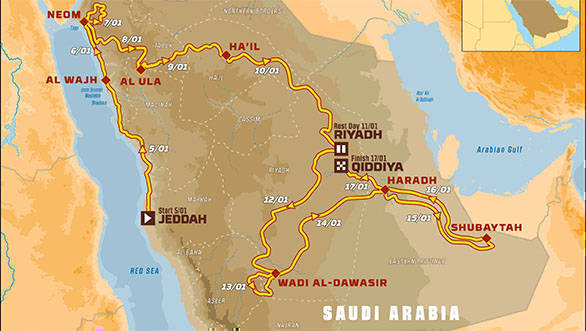Dakar 2020: Participants set to tackle 7500km of gruelling terrain in Saudi Arabia
Who would have thought that getting completely and thoroughly lost in the sands of a desert would inspire someone to dream up the world's most gruelling off-road endurance race. But that is exactly what happened to Thierry Sabine. Back in 1977, Sabine, then a competitor in the Abidjan-Nice Rally found himself lost in the Ténéré desert. And while other people might have panicked in the same situation, Sabine merely decided that getting lost in the desert was a challenge worthy of turning into a competitive event. And so in 1979, the first Dakar Rally was held, going from Paris, France, all the way to Dakar, Senegal.
 Giniel De Villiers (ZAF) of Toyota Gazoo Racing SA tests prior to Rally Dakar 2020 in Jeddah, Saudi Arabia
Giniel De Villiers (ZAF) of Toyota Gazoo Racing SA tests prior to Rally Dakar 2020 in Jeddah, Saudi Arabia
The Dakar became known as THE rally. A rally so long and so punishing to both man and machine, that winning it really was the ultimate prize. People from various disciplines of motorsport took to the event, fielding cars, motorcycles, and trucks. Laying their hands on that coveted trophy - designed to look like a bedouin - was the ultimate goal. The Dakar attracted names like Le Mans legend Henri Pescarolo, F1 and Le Mans star Jacky Ickx (who won the event in 1983), and WRC legend Ari Vatanen (who won in 1987, 1989, 1990, 1991). It created legends out of mere mortals - take for example Vladimir Chagin who is known as the Tsar of Dakar having won the truck category a full seven times. Or Stephane 'Mr Dakar' Peterhansel who has six wins at the event on a motorcycle, and seven wins in a car. And the Dakar also made motorsport fans from all over the world go flocking to the countries that hosted it.
But, with the passage of time and changing political scenarios, the rally itself changed. In 2008 the event, due to start in Lisbon, Portugal, was called off because of feared terrorist attacks in Mauritania. And so the Dakar shifted to South America. Between 2009 and 2019, the Dakar bivouac made 11 visits to the continent, with the rally being held in Peru, Bolivia, Argentina and Chile. The essence of the event remained the same, even if it no longer featured the sands of the Sahara. There was, instead, the Atacama and the Sechura deserts. The riders were pushed to their extreme when they needed to cross into Bolivia, battling cold and altitude sickness en route the world's highest capital city - La Paz. And competitors were treated to some amount of comfort as they went into Argentina, glad, almost, that the worst was already behind them. The event didn't run without criticism, though, especially after the 2014 edition damaged archeological sites in Chile.
In 2019, though, the Dakar was held entirely in Peru, when neighbouring countries - Chile, Argentina and Bolivia - failed to come to an agreement with the Amaury Sports Organisation (ASO). In April 2019 the ASO confirmed that the Dakar would move to Saudi Arabia in 2020, having bagged a five-year contract to host the event. The move did raise a few eyebrows, with more than just a few people questioning the ASO's decision to move to the country. Two days before the first stage of the rally kicked off, Human Rights Watch ran an article about how the country was a "repressive" environment in which to hold an event like the Dakar.
 Seventy five percent of the 2020 edition of the Dakar will be held in sand
Seventy five percent of the 2020 edition of the Dakar will be held in sand
However, now the rally is already underway. Saudi Arabia hosting the Dakar also means that the event is finally back in the land of the bedouin. Competitors will have to traverse a distance of 7500km (75 percent of the rally will be held in sand), moving through the desert, and also through the Asir mountain range. As far as terrain goes, the country has plenty of it to offer, with approximately 1.4 million square miles to pick from. Three of the special stages are meant to be incredibly difficult, extending over more than 750km, which means that competitors will be brought to the very limits of their endurance. Here, then, is a quick overview of the 2020 rally route:
Stage 1 January 5
Start - Jeddah
Finish - Al Wajh
Total distance - 752km
Special - 319km
Stage 2 January 6
Start - Al Wajh
Finish - Neom
Total distance - 401km
Special - 367km
Stage 3 January 7
Start - Neom
Finish - Neom
Total - 489km
Special - 404km
Stage 4 January 8
Start - Neom
Finish - Al- Ùla
Total - 676km
Special - 453km
Stage 5 January 9
Start - Al- Ùla
Finish - Ha'il
Total - 563km
Special - 353km
Stage 6 January 10
Start - Ha'il
Finish - Riyadh
Total - 830km
Special - 478km
Rest day January 11
Stage 7 January 12
Start - Riyadh
Finish - Wadi Al Dawasir
Total - 741km
Special - 546km
Stage 8 January 13
Start - Wadi Al Dawasir
Finish - Wadi Al Dawasir
Total - 713km
Special - 474km
Stage 9 January 14
Start - Wadi Al Dawasir
Finish - Haradh
Total - 891km (Longest Stage of the Rally)
Special - 415km
Stage 10 January 15
Start - Haradh
Finish - Shubaytah
Total - 608km
Special - 534km
Stage 11 January 16
Start - Shubaytah
Finish - Haradh
Total - 744km
Special - 379km
Stage 12 January 17
Start - Haradh
Finish - Qiddiya
Total - 447km
Special - 374km
Related Stories
Top Stories
Latest Videos
Most Popular
- Budget Sportbike Showdown: Kawasaki Ninja 500 vs Aprilia RS 457 vs Yamaha YZF-R3
- Mumbai-Pune Expressway speed restrictions updated
- 2014 Triumph Daytona 675 vs 2024 Kawasaki ZX6R - A Decade of Evolution in Supersport Motorcycles
- Upcoming Mahindra XUV 3XO: All you need to know
- 2024 Hyundai Creta vs Toyota Urban Cruiser Hyryder vs Skoda Kushaq comparison review - the hype is real?














